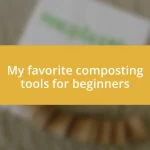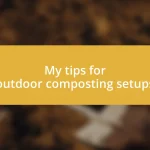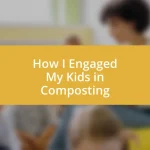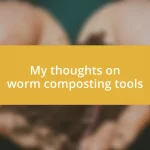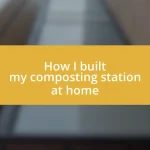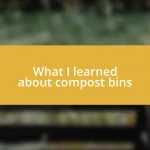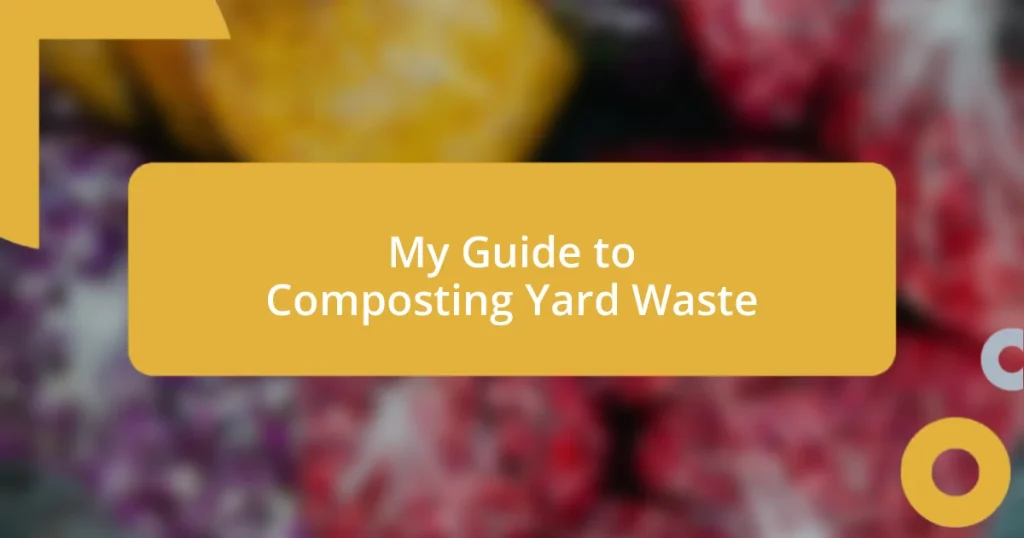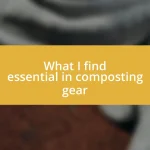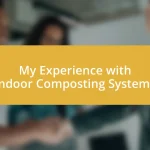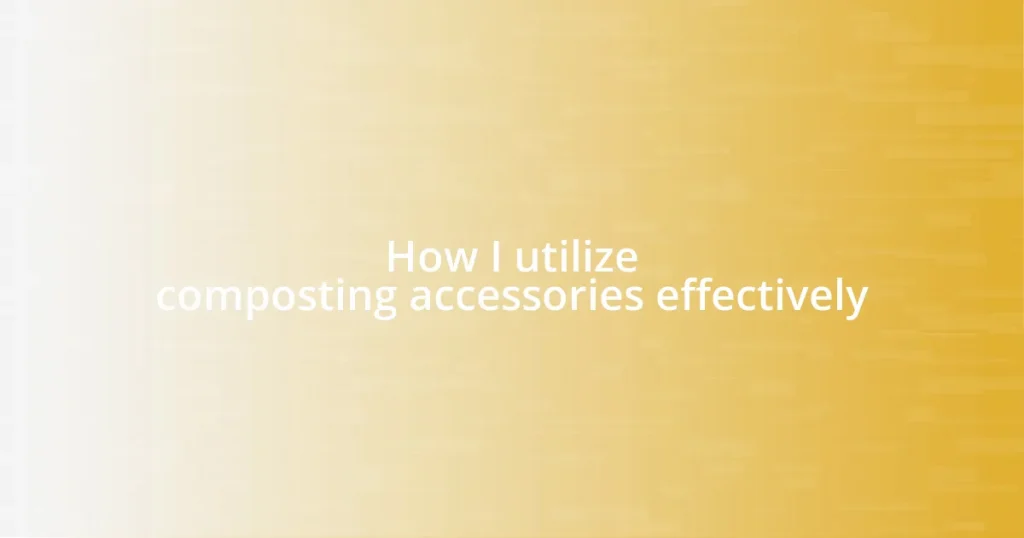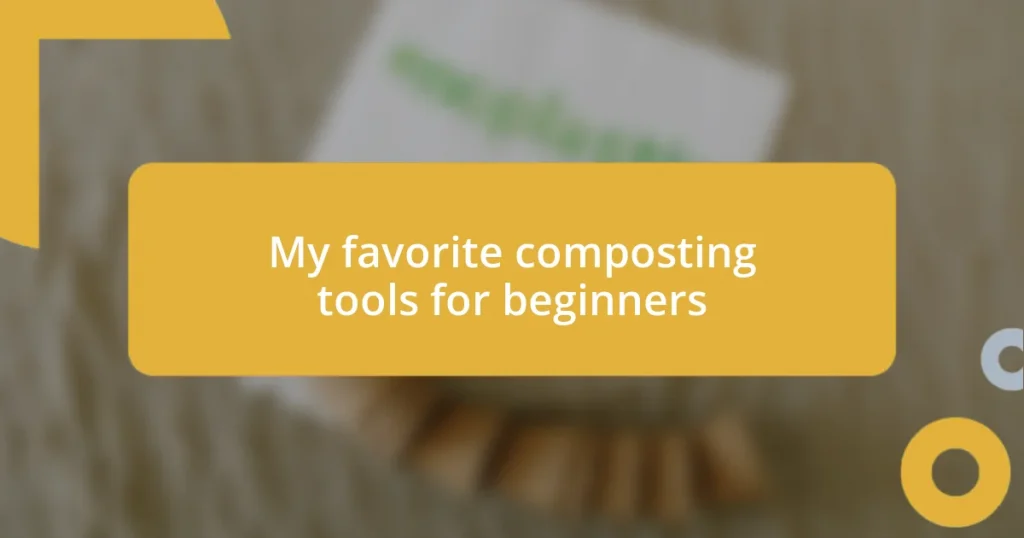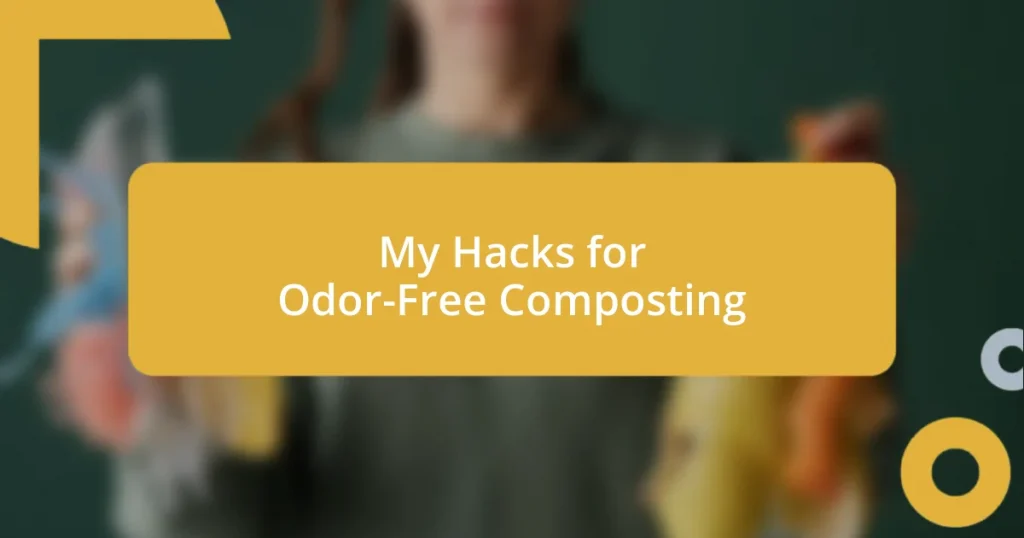Key takeaways:
- Composting reduces waste and enriches soil, fostering healthier plants and a sustainable gardening cycle.
- Maintaining a balanced mix of nitrogen-rich greens and carbon-rich browns is essential for effective composting.
- Regular monitoring, turning the compost, and using finished compost in gardening significantly enhance plant growth and garden health.

Understanding composting benefits
Composting offers a treasure trove of benefits, both for the environment and for those of us who garden. I remember the first time I saw my compost pile transform from a heap of leaves and kitchen scraps into rich, dark soil. It felt like magic! Not only am I reducing waste that would otherwise end up in a landfill, but I’m also enriching my garden soil, creating a thriving space for my plants.
Consider this: every time you add scraps to your compost, you’re not just reducing waste—you’re actively contributing to a sustainable cycle. It gives me a sense of satisfaction, knowing that I’m playing a part in something larger. It reminds me of when I see my tomatoes thriving and bursting with flavor; that healthy soil is the foundation. It’s rewarding to witness the impact of nature’s recycling process firsthand!
Furthermore, composting can significantly cut down on the need for chemical fertilizers, which is a major win for the environment. I recall a gardening friend who once claimed that her compost was her garden’s secret weapon. This simple act of composting not only fosters healthier plants but also keeps harmful substances out of our waterways. Isn’t it uplifting to think that by composting, we’re nurturing both our own gardens and the planet?

Choosing the right compost materials
Choosing the right compost materials is crucial for creating high-quality compost. I remember the first time I dove into my composting journey; I was overwhelmed by the choices! There’s a delicate balance between greens—like grass clippings and vegetable scraps—and browns, such as dried leaves and cardboard. The greens are high in nitrogen, which fuels the decomposition process, while the browns provide carbon, essential for energy. Finding that right mix not only enhances the composting process but transforms your bin into a powerhouse of nutrition for your garden.
As I experimented with different materials, I realized that not everything makes the cut. For example, some people treat their compost like a catch-all, tossing in everything from meat to dairy. However, I’ve learned the hard way that these items can attract pests and create odors. Instead, I focus on veggie scraps, coffee grounds, and eggshells to keep my compost pile healthy. Have you ever smelled a compost bin gone wrong? It’s a lesson I won’t forget, and I encourage you to steer clear of those pitfalls!
It might also surprise you to know that not all yard waste is created equal. When I first started composting, I thought all plant materials were perfect for the pile. Yet, some plants, like invasive species or those treated with pesticides, can introduce unwanted issues. It’s vital to be discerning, as the integrity of your compost can directly affect the health of your garden. Paying close attention to what goes into your compost not only enriches the soil but also helps ensure that your plants flourish.
| Type of Material | Examples |
|---|---|
| Greens (Nitrogen Rich) | Grass clippings, vegetable scraps, coffee grounds |
| Browns (Carbon Rich) | Dried leaves, straw, cardboard |
| Materials to Avoid | Meat, dairy, oily food, invasive plants |

Preparing yard waste for composting
Preparing yard waste for composting is all about being mindful of what you add to the pile. I remember the excitement of gathering my yard waste for the first time. It felt like I was collecting little treasures! To kick off the composting process, it’s essential to chop larger items into smaller pieces. This simple step helps speed up decomposition and encourages a well-mixed compost pile.
Here are some quick tips for preparing yard waste:
- Cut or shred: Break down branches and leaves into smaller sizes to promote faster decomposition.
- Mix different materials: Combine soft and hard yard waste, like grass clippings with twigs or dried leaves, for a balanced carbon-to-nitrogen ratio.
- Moisten dry materials: Lightly water dry yard waste to help initiate the breakdown process.
- Avoid dampness: Ensure no material is overly wet; this can result in unpleasant odors.
- Layer wisely: Alternate layers of greens and browns, which will create the perfect environment for microorganisms.
I’ve learned that the right preparation fosters a thriving compost ecosystem. Last summer, I watched in awe as kitchen scraps melded beautifully with my yard waste to create rich compost. Seeing my plants flourish with this homemade goodness affirmed my commitment to composting. It’s a delightful journey, isn’t it?

Building an effective compost pile
Building an effective compost pile is truly an art, and I’ve learned that layering is key. When I first tried composting, I simply tossed everything in together, thinking it didn’t matter much. But once I started alternating layers of greens and browns, I noticed a significant difference. This method improves airflow and moisture retention, creating a robust environment for decomposition. Have you ever noticed how quickly the pile breaks down when it’s well-structured?
Another aspect that’s made a world of difference for me is the size of the pile. My early compost endeavors were a bit on the small side. Once I realized that a compost pile needs to be about three feet by three feet to generate enough heat for effective composting, everything changed! That heat is essential because it speeds up the breakdown process, helping to transform your materials into nutrient-rich compost in no time. When I saw my first batch of finished compost, it felt like the reward for all that patience and care I’d put in.
Lastly, monitoring your compost pile with a little bit of attention can yield phenomenal results. Initially, I was hesitant about turning my pile, but when I started to rotate it every couple of weeks, the benefits were undeniable. Turning the compost introduces oxygen, which is crucial for the microbes doing all the hard work. If you’ve ever been curious about what goes on inside that pile, just know that it’s a bustling microcosm of activity! Being an active participant in your composting journey can transform a simple pile into a productive powerhouse for your garden.

Maintaining your compost pile
Maintaining your compost pile is an ongoing adventure that really calls for your attention. I’ve found that keeping a consistent routine is vital. For instance, I set a weekly reminder to check on moisture levels. There’s something satisfying about gently squeezing a handful of compost material and feeling the perfect dampness—just enough to clump without dripping water. Have you ever experienced that “aha” moment when everything feels just right in your compost pile?
Turning the pile regularly is essential, and I remember how hesitant I was to start. Initially, it felt like I was disturbing something important, but it turned out that turning the compost is vital for aeration. I often use a pitchfork to mix it up, and the earthy smell that rises is a beautiful reminder of the life happening within. With every turn, I notice the temperature rise, welcoming that heat as an encouraging sign of decomposition in action!
Another crucial aspect I’ve learned is to watch for signs that something isn’t quite right. If my compost pile starts to smell sour, I know it’s time to add more dry materials—preferably those glorious browns. When I faced this issue for the first time, I was panicking a bit; I thought I had ruined my efforts. However, with a little adjustment and care, the smell dissipated, and it became a learning experience that made me feel more in tune with my composting journey. This kind of hands-on maintenance can turn potential setbacks into growth opportunities.

Troubleshooting composting problems
When I first encountered problems with my compost pile, the whole experience felt a bit daunting. One day, I noticed it was damp without the delightful earthy smell I had come to expect. It turned out to be an imbalance—too many wet materials! Is there anything worse than putrid compost? I quickly added more dry browns, like shredded leaves and cardboard, and soon enough, that fresh, inviting scent returned. It was a clear reminder that attention to balance is vital in composting.
I remember one summer, my pile produced a noticeable odor of ammonia. I was worried! That sharp smell indicated too much nitrogen-rich material, making it a prime candidate for trouble. To rectify the situation, I incorporated more carbon-rich layers and even added a handful of soil to introduce some helpful microbes. The quick turnaround was almost magical—within a few days, the smell dissipated. Have you ever felt the thrill of solving a compost crisis? It can be incredibly rewarding!
There are times when I’ve noticed my compost pile slowing down, and it felt like a lull in my gardening journey. Back then, I didn’t realize that temperature plays such a crucial role. Using a compost thermometer has transformed my approach. Monitoring the heat has allowed me to adjust my composting methods. When I saw the numbers dip, it prompted me to turn the pile and add some fresh greens. Turning it felt like giving my compost new life, and the rising temperatures went on to prove that every composting challenge is just a chance to learn more!

Using finished compost effectively
Using finished compost effectively is a game-changer for any gardener. I remember the first time I spread my homemade compost across my garden beds—the richness of the soil felt like a gift I was giving to my plants. What I love most is how that nutrient-dense compost sets the stage for vibrant growth, fostering an environment that nurtures every seedling.
One of my favorite applications of finished compost is as a top dressing for potted plants. The moment I sprinkle it on the surface, I can almost sense the plants’ excitement! It not only feeds them but also helps retain moisture in the soil, which is crucial since I’ve learned that indoor plants can sometimes struggle with drying out quickly. Have you ever watched your plants respond positively after a good feeding? It’s truly heartwarming.
I also enjoy mixing compost into my vegetable garden before planting. When I first tried this, I was amazed at the difference it made in both soil quality and crop yield. The earthy texture and rich nutrients seem to create an atmosphere of abundance. It’s like inviting life into your garden! I often wonder how nature has such a perfect recycling system, and using my compost feels like joining in on that wonder. The more I incorporate my finished compost into these various aspects of gardening, the more I realize how essential it is to maintain a sustainable cycle in my gardening practices.

